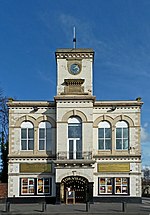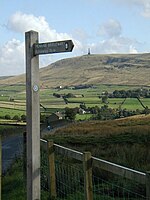Knottingley

Knottingley is a town in the City of Wakefield in West Yorkshire, England on the River Aire and the old A1 road before it was bypassed as the A1(M). Historically part of the West Riding of Yorkshire, it has a population of 13,503, increasing to 13,710 for the City of Wakefield ward at the 2011 Census. It makes up the majority of the Knottingley ward represented on Wakefield Council. Until 1699, it was an important inland river port but, in that year, the Aire was made navigable as far as Leeds, which soon surpassed it. Knottingley continued as a centre for boat building into the 20th century. In the late 19th century, it started glass manufacturing. The town is served by Knottingley railway station. After 1870, the town became known for glass manufacturing. In 1887, Bagley's Glassworks purchased the rights to the first bottle-making machine, invented by a Ferrybridge postmaster. There is a Bagley's Glass gallery in Pontefract Museum. Close to Knottingley is Ferrybridge Power Station, which had the largest cooling towers of their kind in Europe. Three of these towers collapsed in high winds in 1965. The remaining towers, which could be seen for miles around, were demolished between 2019 and 2022. The town was the last in the United Kingdom to have a working deep coal mine, Kellingley Colliery, until it closed in December 2015.
Excerpt from the Wikipedia article Knottingley (License: CC BY-SA 3.0, Authors, Images).Knottingley
Westfield Avenue, Wakefield
Geographical coordinates (GPS) Address Nearby Places Show on map
Geographical coordinates (GPS)
| Latitude | Longitude |
|---|---|
| N 53.705 ° | E -1.249 ° |
Address
Westfield Avenue
Westfield Avenue
WF11 0JH Wakefield
England, United Kingdom
Open on Google Maps









